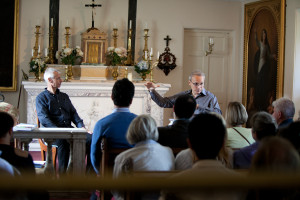
The 4ročník Knihy, Hranice a kolesá Festival sa konala na najdlhšej Škótska nepretržite obývaná obydlia, Traquair Dom na rieky Tweed v škótskych hraniciach. Organizuje Beyond Borders Škótsko je jedinečný festival literatúry a myslenia, ktorá združuje popredné spisovatelia, politici, vojaci, lawyers and artists to discuss topics relevant to international relations Scotland’s role in the world. Two talks “Understanding the Islamic World” and “Iraq Ten Years On: Aké poučenie pre Sýriu a U.N.?"Niesť svedectvo šírke diskusie. SNSI coordinator, Robert Wild zúčastnila dvoch akcií; prechádzka s názvom "Keby stromy mohli hovoriť – čo povedia?", a hovoriť o "Neuroscience starých a Svätá prírodných stanovíšť".

Skupina na ceste s Ianom Edwards, vedúci udalostí v Royal Botanic Garden Edinburgh, diskutovať o kultúrne združenia stromov, zatiaľ čo Catherine Maxwell, ktorého rodina bola v rezidencii pre 300 roky za predpokladu, že história stromov. (Photos courtesy Beyond Borders)
Nedeľné ráno bolo chôdze 'Hovoriace Science Project"V spolupráci s Royal Botanic Garden Edinburgh. Je to preskúmal Traquair historickej krajiny a objavil príbehy jeho úžasné stromy (www.traquair.co.uk). Ian Edwards, vedúci udalostí v Royal Botanic Garden Edinburgh, viedol diskusie o biogeografických históriou a kultúrne združenia stromov panstva vrátane Yew, Vápno, Silver Fir and Hazel. Catherine Maxwell Stuart, vlastníkom a ktorého rodina bola v rezidencii pre 300 roky za predpokladu, že história stromov.
Skupina skončila s diskusiou v rámci kontemplatívny miesto vytvorené starovekými tisy, ktoré sa zachovali z obdobia dnes už vymastenej lesa Ettrick, pri ktorom Traquair House - lovecký zámoček škótskych kráľov, pretože okolo 1107 – was originally been situated. Robert posed that if trees could talk they may have a few questions of us like: Čo môžete urobiť pre Ettrick lesa? Čo preboha si urobil na polovicu lesov na planéte? Myslíte si predstaviť, že starať sa o nás stromy? Really we look after you!
Following the walk the talk took place inside the packed Chapel. Entitled “Neuroscience starovekej a Sacred prírodných stanovíšť: Why ancient places evoke such a powerful hold over our culture and should be protected during times of conflict”, the talk explored Sacred Natural Sites and made links to the emerging understanding of Neuroscience.
Robert kicked off saying that Sacred Natural Sites can be described as places where the human mind meets Nature. He observed that the Traquair chapel (ktorá je relatívne nová upravených na tento účel v 1829) mal málo zmienok o prírode, ale že je veľmi pravdepodobné, že všetky naše posvätné priestory pôvodne odvodený z prírody.
Robert pokračoval v opise posvätných prírodných lokalít a prečo získali záujem medzinárodného hnutia ochrany. Nature conservation practitioners have a very pragmatic interest in sacred natural sites as they protect a wide range of rare species. This is particularly important as we have now entered the 7ročník veľká udalosť zániku, with hundreds of species becoming extinct daily. Beyond this, však, posvätná prírodné lokality tiež vložiť hlboké súbor archetypov ľudských vzťahov, ktoré môžeme učiť od v nastavení udržateľnejšiu cestu pre ľudstvo.
Jedným z týchto poňatí je to "Svätyňa" that seems to be a direct import from ancient European sacred groves into the early Christian church. Sanctuary arose in the sacred groves of Europe where, no hunting was allowed and if a hunted animal found refuge in a sacred grove the hunt had to stop. Human fugitives could also find sanctuary in the sacred grove. Many of these provisions still hold in the sacred groves of Africa and Asia. At some point this sanctuary principle transferred into the church.

Predtým, než sa dostal do neurovied posvätnej, Robert Divoké (vľavo) explored sacred sites as potential areas for limiting conflict. (Photos courtesy Beyond Borders)
Konečne, a ako sa dostane do neurovied posvätnej, Rob focused on sacred sites as potential areas for limiting conflict. Rob presented an example recently shared by colleagues at the Aigine Cultural Research Centre týkajúce sa 2010 Kirgizská konflikt, kde boli stovky ľudí zabitých a tisíce posunutý konflikt medzi kirgizština a Uzbekmi na juhu krajiny. Mnoho presídlencov našiel útočisko v posvätnom mieste byť bezpečné útočisko v čase konfliktu:
"Kamchieva Mopasha etnické uzbeckej romány a"shaiyks"Alebo opatrovník webe štátov: “Keď je katastrofa, ľudia prichádzajú na posvätné miesto a nájsť útočisko ". According to her, vo výške konfliktu v júni 2010, [mnoho ľudí] tam šiel ako Kirgizská a Uzbekov, ale oni neboli pýtať, kto je kto, [ale] spoločne hoviad Bohu, žiadal o obnovenie mieru a harmónie. Mnohí pútnici zostal pre tie dva alebo tri dni [konfliktu] na okraji Mazar (Posvätné miesto). As [jeden respondent] Akbarov Salbar said, "Nie jeden nosa alebo úst, kto bol zranený". Ďalšie respondent uviedol, že posvätné miesta sú oblasti, nenásilia, and moreover places where steps are taken to overcome violence”.
At this point Robert then handed over to Tim Phillips. Tim is an international peace maker and co-founder of the Harvardská univerzita Projekt na dvor v čase prechodu a bol zapojený do mnohých mierových rokovaniach, vrátane Severného Írska, Srí Lanka a Stredný východ.
Tim introduced the emerging discipline of neuroscience and discussed recent lessons that are being learnt in relation to conflict resolution. This includes that different types of thought pattern are processed in different parts of the brain. Different parts of the brain process different emotions and thoughts that are analogous the stages of evolution. Rational thought is now understood to be processed in a different part of the brain that deeply held and sacred values. These new understandings have profound implications for the way that we negotiate over issues. This is the case when seemingly rational solutions to deeply held or sacred values will not be easily considered by negotiating teams.
Sacred natural sites have been contested lands at the same time locations of peace and cooperation. They also embed critical models of human relationships with nature. At a time when our relationships with nature need significant healing; duchovný, vedecké a spoločenské chápanie ľudského správania a konania sú nevyhnutné.






